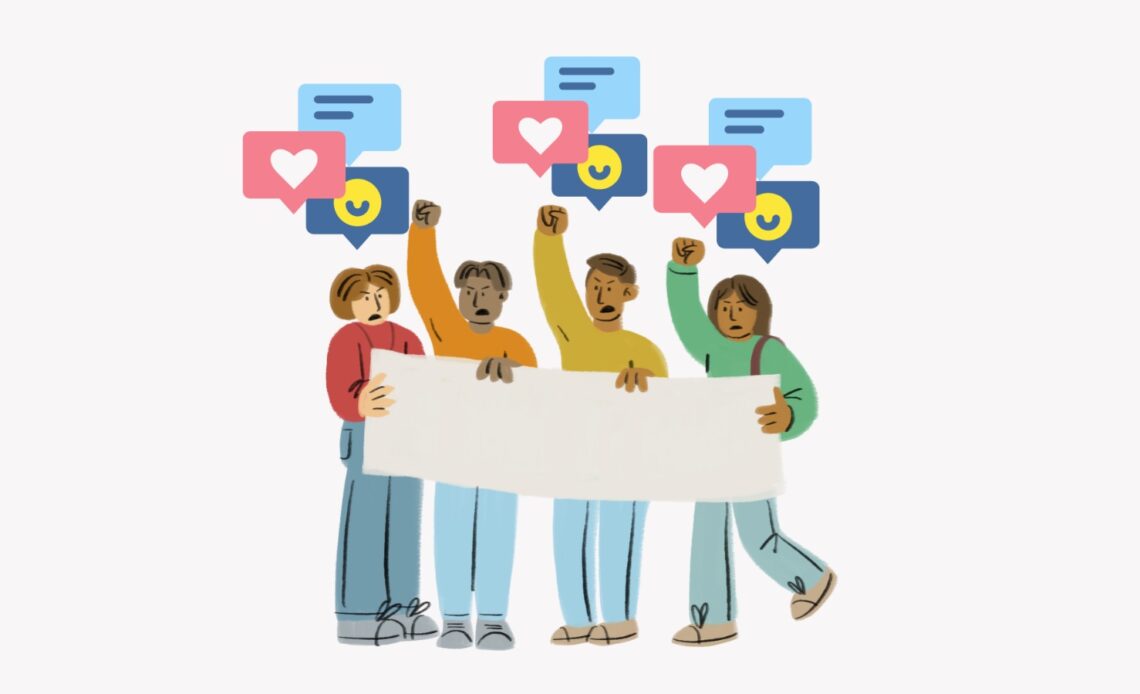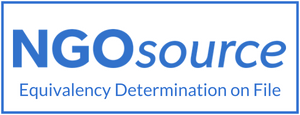I was a mere 9 years old when I witnessed my first social media movement. It was called the ALS Ice Bucket Challenge—an initiative which, through filming videos of ice buckets being dumped onto people’s heads and uploading them on social media platforms, brought the global spotlight to a life-threatening disorder called amyotrophic lateral sclerosis (ALS). Later, I would also witness social media-propelled movements like Black Lives Matter and Stop Asian Hate, displaying to me the massive collective power of people.
Early Exposure to “Social Media Activism”
My exposure to social media from a very young age is not uncommon to Generation Z, the only generation that has never known life without the existence of the Internet. The term “Gen Z” originated in the United States, but interacting with teenagers in Indonesia for the past 3 months has revealed to me that these experiences are shared across the world. Gen Z is geographically and linguistically diverse, yet, through our shared understanding of social media, we participate in and champion trends, challenges, and movements that impact the world.
Activism that takes place on social media platforms, which from here on out will be referred to as “social media activism,” has changed significantly over the past decade. One notable shift is that less effort is needed to engage the youth generation in interacting with current events, which, when combined with high rates of social media literacy, has allowed for movements to more easily reach the global scale. In comparison with the ALS Ice Bucket Challenge, for example, which necessitated something of an easily-viral nature in order to capture the attention of the youth, the information-based social media activism of today is indicative of the highly politically-engaged and curious personality of Gen Z today. The idea of information itself serving as the “hook” for Gen Z also explains why our generation is more easily influenced by information presented on social media compared to previous generations.
One manifestation of a highly information-motivated Gen Z is the soaring popularity of Instagram graphics, which relieves their curiosity for knowledge in a simple, low-commitment way. The quest for knowledge, however empowering it is for youth, has also made Gen Z more impressionable to the information they interact with online. This is best illustrated by the widespread popularity of impact-focused Instagram accounts, like @/impact, @/so.informed, and @/goodgoodgoodco which have goals to “deliver digestible and socially-impactful content,” “help you stay informed,” or “help you feel more hopeful & do more good.” While these platforms with millions of followers are conveniently one-spots for all things news-related, the problem with Instagram accounts that do not specialize in any issues is that many of the topics covered only hit surface-level. Perhaps this is indicative of Gen Z’s desire not to seek depths of knowledge, but rather seek a variety of it, even if it means doing without its details.
Instagram Graphics and Social Media Activism
Graphics on Instagram attempt to communicate with users through visual representations and text. As described by Terry Nguyen in “How social justice slideshows took over Instagram,” they have developed to be highly “bold and eye-catching” with “colorful gradients, large serif fonts, pastel backgrounds, and playful illustrations.” When serving information about social and political issues, content creators utilize bullet points, graphs, quotes, and hand-drawn illustrations. On Instagram, one can find millions of graphics breaking out virtually any topic, from abortion rights to climate change to mental health, without the hassle of searching through the Internet. Graphics can be a valued source of information for both the inexperienced and experienced, which is why many of them have amassed thousands and millions of likes. According to Ellie, a student at Pomona College, “they have made me consider new ways of looking at things, new intersections.” Even for middle and high school students, who may not yet have the research skills to search for reputable news on other platforms, graphics can make highly complex issues simple to understand.
Furthermore, Instagram users now utilize graphics as a way to not only bring exposure to social movements, but also to educate others about substantial issues like racism, war, and climate change. This is in contrast to the characteristics of 2010s social media activism, which Eli Fischer, who was a teenage social media user during that time, explains was “linked to articles or statuses…not graphics.” Graphics now attempt to cover hundreds, or even thousands of years of context into a singular post, which requires cherry-picking favorable evidence to match a particular stance or logical chronology of events. Regardless of the potential biases associated with graphics, the shift in social media’s role in activism has led to social media becoming the most frequently used source of news for Gen Z, with “50 percent of respondents reporting they used social networks as their news source on a daily basis,” according to Statista. This illustrates that simplicity may be the priority for Gen Z when it comes to obtaining news.
As mentioned before, a desire for Generation Z to be educated about social issues has resulted in a high receptivity to graphics, which has increased the ease with which the posts are popularized and spread. According to Nguyen, “they [graphics] can easily be shared countless times — regardless of whether it’s been fact-checked, properly sourced, or proofread — with little or no accountability.” This quality, as well as the relative fairness with which everyone has achieved virality on Instagram, has granted minorities more power in influencing majority opinions. However, the accessibility that existing social media users are offered also results in a huge influx of misinformation and disinformation. Shehita, a third-year at SMAN 7 Yogyakarta, comments that “I see infographic content on Instagram, there’s sometimes a lot of miscommunication between people in the comments. If the infographic is complete and clear, I can understand what the sender wants to convey.”
It is important to emphasize that the impact of Instagram graphics goes far beyond the spread of misinformation and disinformation. During one peak of the Black Lives Matter movement in May 2020, I recall many moments of positive self-realization that were spurred by what Instagram content I was exposed to at the time. Yet, I also recall feelings of guilt, confusion, and hypocrisy that were provoked by the same graphics I saw online, often making me feel as though I needed to post in support of the movement, even though I wasn’t always prepared to do so. Kaitlyn, a second-year at the University of California Los Angeles, similarly recalls that she “felt embarrassed to be controlled by the grasp of social media…even though it’s partly my fault.” These experiences illustrate that although graphics don’t always spread false information, the design of them gives rise to issues like a depleting willingness to engage with political and social issues authentically and guilt as a driving force of social movements.
The Impact of Instagram Graphics on Gen Z Attitudes Towards Social and Political Issues
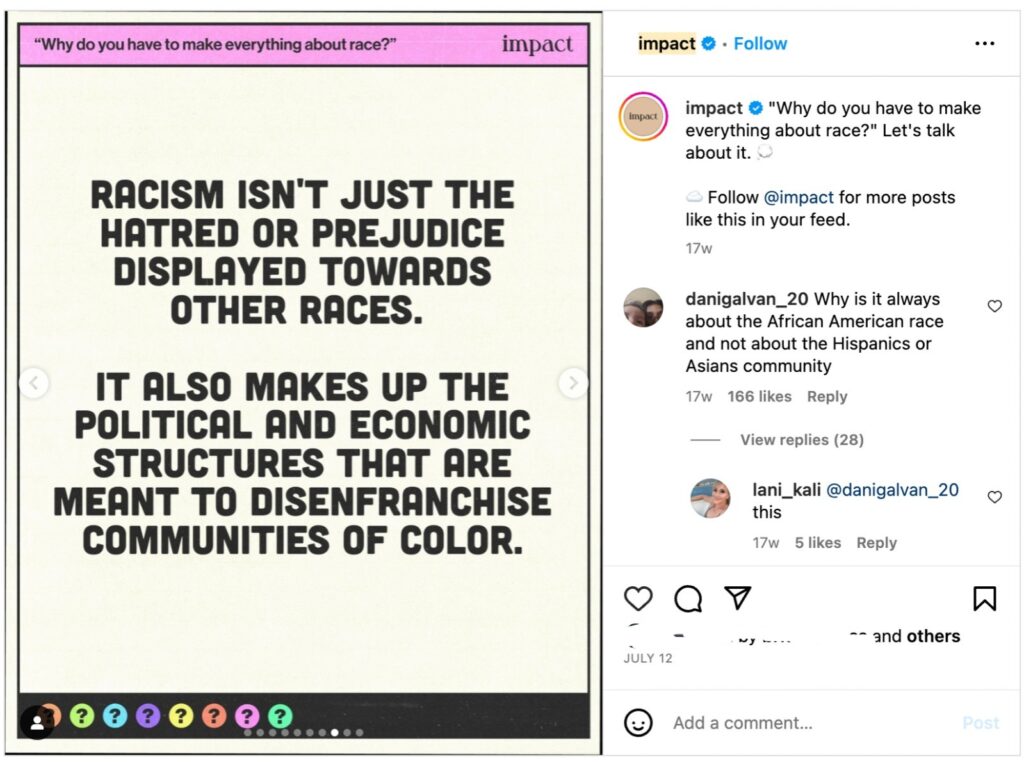
There are numerous types of Instagram graphics that have emotional impacts on Gen Z.
The first type of graphic may intimidate social media users, especially if they do not have previous knowledge about the topic. This tendency to intimidate is reflected in the manifestations of the Black Lives Matter movement in 2020, which was begun by Black Lives Matter, an organization founded in 2013 to “eradicate white supremacy and build local power to intervene in violence inflicted on Black communities by the state and vigilantes.” This graphic posted by @/impact, for example, makes a claim about the relationship between racism and types of structures, but does not give any reasoning justifying this relationship. The rise of such posts is indicative of the trend in “virtue signaling” within social media, which, according to the Oxford Dictionary, is a term used to describe “the public expression of opinions or sentiments intended to demonstrate one’s good character or social conscience or the moral correctness of one’s position on a particular issue.” While a social or political movement is often charged by the desire to influence the viewpoints of others, statements like these are purposeless as they provoke opposition and intimidation but do not actually garner support. According to Kaitlyn, “it raises questions about the nature of authentic expression, the impact of genuine actions versus the frequency of virtual declaration.” The shift of intentions behind graphics from genuine support to this “virtual declaration” may diminish the effectiveness of the social movement outside of social media by deepening the disparity between support shown on and off the media.
On a larger scale, the Black Lives Matter movement has experienced many fluctuations in social media exposure, most notably a monumental spike after the death of George Floyd in 2020, then a significant decline in the years following. One reason for this decline is the frequent usage of jargonistic words like “disenfranchise” and “prejudice.” Circulating terms lacking precise definitions like these may have intimidated people rather than educating them. Furthermore, in a general sense, the fact that the movement was largely propelled by the sharing of graphics online may have contributed to this decline because many of these graphics largely emphasized short-term initiatives, such as the signing of petitions, the calling of governmental representatives, and reposting graphics, rather than also emphasizing that the pursuits of Black Lives Matter—”to bring justice, healing, and freedom to Black people across the globe”— do not simply end when these short-term goals are met.
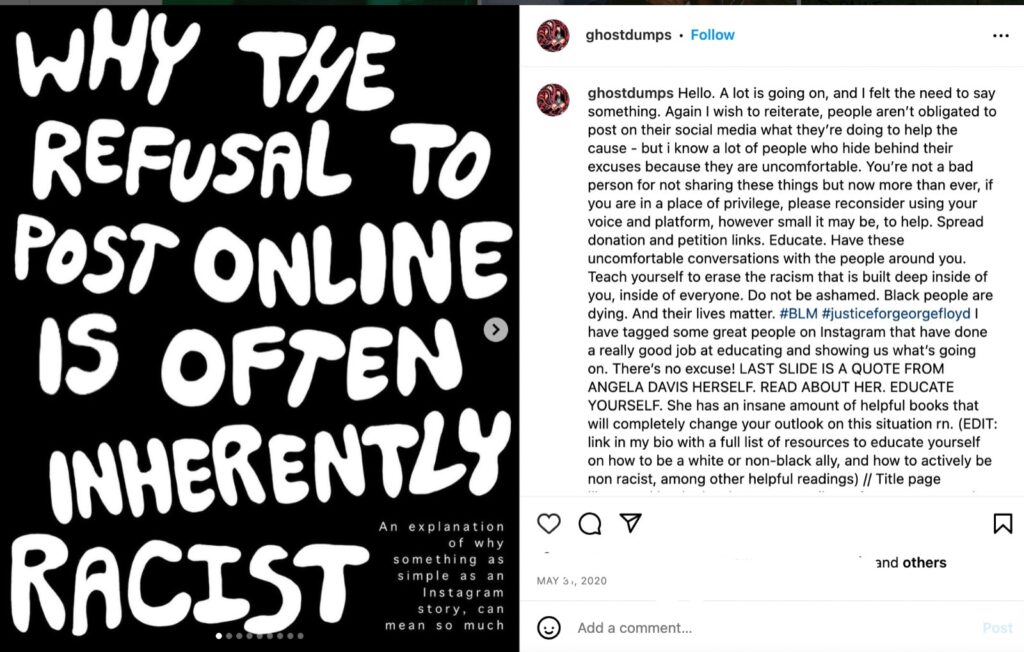
The second type of graphic attempts to provoke individuals through guilt. This graphic which reached virality in 2020, for example, claims that “the refusal to post online is often inherently racist.” By generalizing all people who choose not to post certain types of content under one extraordinary claim, this graphic invalidates the fact that users may choose not to engage in social media activism for a variety of other reasons. As elucidated by Elizabeth Spiers, an Opinion writer for The New York Times, a pressure to post on social media “does not leave time or space for people to process traumatic events…before pronouncing a judgment” and “implies it’s not OK to have…any kind of moral analysis that does not lend itself to presentation in a social media post.” The emotions provoked when users feel personally attacked for their decision to not post may also make them more skeptical towards the intentions of the social movement. Furthermore, by equalizing the value of posting on social media as so important that not doing so could legitimize such strong feelings of guilt may diminish the value of the other ways with which people initiate change, like public speaking.
The judgment with which some social media users approach posting or not posting on social media is most detrimental for social users without much experience in social and political issues, because the negative feelings that may be associated with social media activism may discourage them from engaging with them entirely. A fourth-year attending Yogyakarta State University explains that “I’m a little afraid to post something on Instagram that is related to social or political issues because I think many people don’t like this.” Likewise, Shehita, a third-year attending SMAN 7 Yogyakarta expresses that she’s “afraid to make posts that smell of Indonesia politics.” These accounts exemplify a rising culture of judgment among youth and social and political issues all over the world, which, when utilized to motivate Instagram users to post in support of social movements, is antithetical to the purposes of the movements themselves.
Similarly, in pushing forth simplicity, graphics contribute to sharp polarizations by overlooking important nuances in social and political issues. We can see this manifest in the current conversations surrounding the events in Palestine and Israel, where many arguments have taken to the extreme, such as by pronouncing that those supporting the existence of a free Palestine are “anti-semitic” or “pro-Hamas,” or that those grieving the deaths of Israelis are “pro-genocide.” The simple binaries through which the events are presented in Instagram graphics have contributed to the simmering down of the complex history of Palestine and Israel into a sharp “pro-Palestine” vs. “pro-Israel” debate. This is manifested in an Instagram post by @/stateofisrael responding to a graphic that Gigi Hadid, an American celebrity with over 79 million followers on Instagram, reposted on her story. For simply making the point that supporting Palestinians does not make her antisemitic or a supporter of ISIS, she is accused of “turning a blind eye” to the lives of those who are Jewish. Graphics often tend to extreme stances, which overlooks nuances and leads many people to feel misunderstood and generalized. This is not only an example of extreme polarization, but similarly to the discourse which took part in Black Lives Matter, also an illustration of how silence itself has become a stance in many social movements.
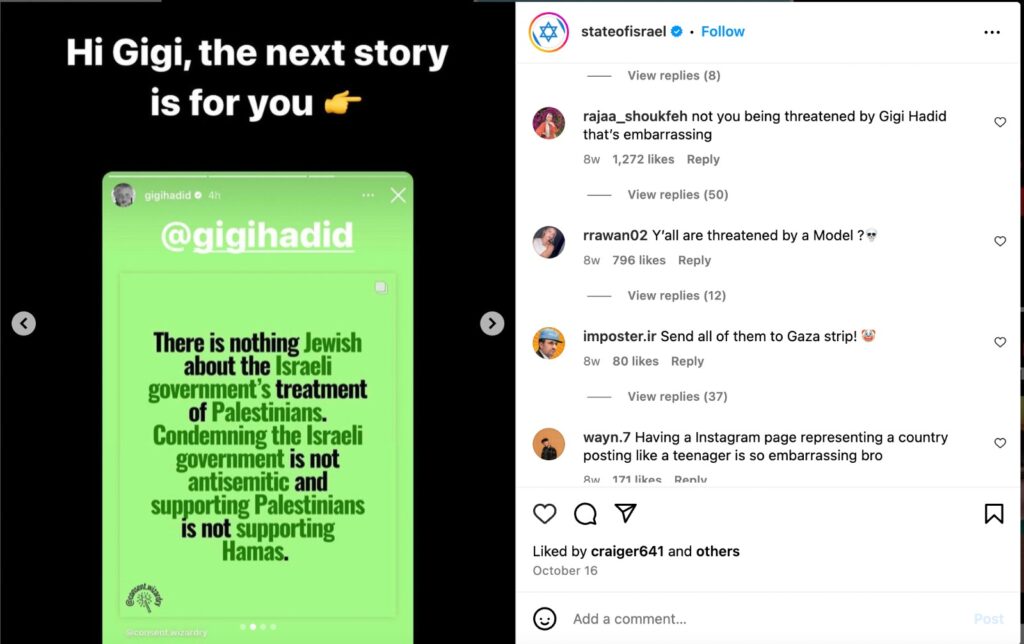
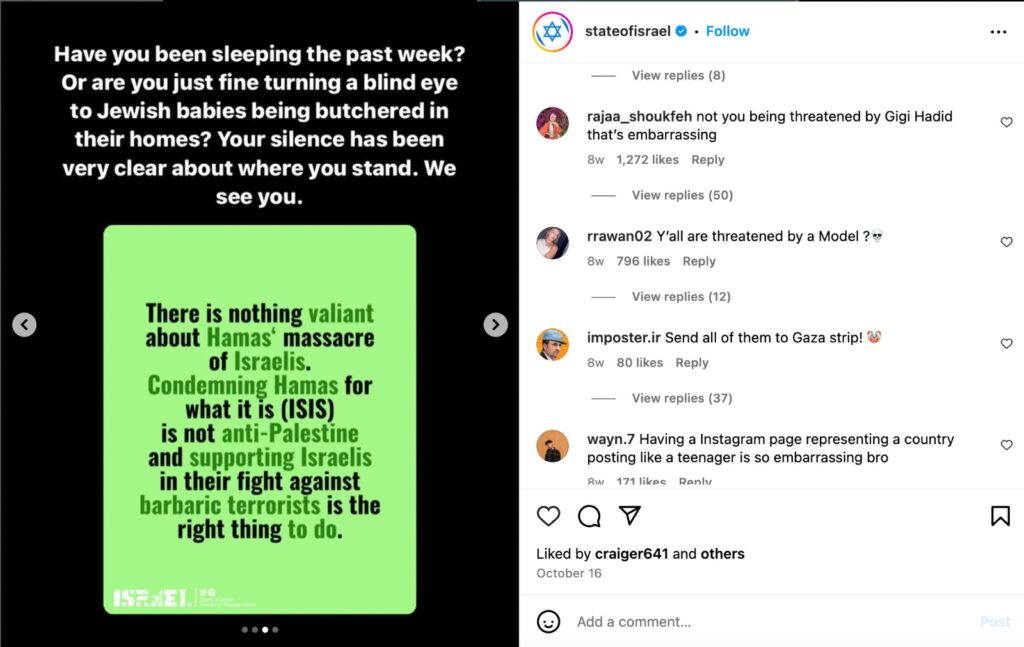
Closing Thoughts
All in all, the very nature of graphics implies that complex, multifaceted issues can be represented within the limitations of a graphic post. When content creators are overly intent on appealing to their audience through simplicity, they are conveying that the issues may be easily resolved. The simplifications of complex issues result in social movements that are either short-lived, quickly mellow down, or experience fluctuations of growth and decline.
On a generational level, as explained by IndoProgress in “Generation Z Politics: From Social Media to Real Movements,” we are becoming “more product-oriented than goal-oriented.” The changes in attitude within social media activism have contributed to a culture that feels incredibly hasty, focusing on quick results rather than ones that last in the long-run: individuals are often expected to immediately form and post about their opinions, social movements experience fluctuations rather than consistent support, and we, Gen Z, are often focused on widening, rather than deepening, our knowledge.
Although it is easy to entirely criticize developments like Instagram graphics for contributing to a generational emphasis on haste, the trusting nature of consumption of Gen Z is also to blame. However, a shift towards a youth culture that is more accepting of individuality, aware of nuances, and understanding of differences is possible as long as we understand the importance of critical thinking when faced with information online. Instagram graphics should always serve as starting points, with which we pursue further learning, understand that nuances exist, and recognize that the emotions that may be provoked by them should not discourage us from learning or making mistakes.[]
Sources:
- https://www.nytimes.com/2023/10/17/opinion/social-media-israel-palestine.html
- https://www.pewresearch.org/social-trends/2020/05/14/on-the-cusp-of-adulthood-and-facing-an-uncertain-future-what-we-know-about-gen-z-so-far-2/
- https://www.vox.com/the-goods/21359098/social-justice-slideshows-instagram-activism
- https://www.indoprogress.com/2019/12/politik-ala-generasi-z-dari-media-sosial-menuju-gerakan-nyata/
- https://www.forbes.com/sites/paulmonckton/2020/06/02/blackout-tuesday-instagram-black-squares-blackouttuesday-theshowmustbepaused/?sh=355b0c8a2794
- https://fliphtml5.com/rmpye/lcpb/Indonesia_Gen_Z_Report_2022/
Irene Kim adalah mahasiswa S1 di Universitas Princeton yang sedang kuliah di Universitas Negeri Yogyakarta (UNY). Dia berasal dari Korea Selatan dan tinggal di Amerika Serikat. Ia memiliki minat kajian hubungan internasional dan hubungan masyarakat. Saat ini bekerja sebagai relawan di Combine Resource Institution.

